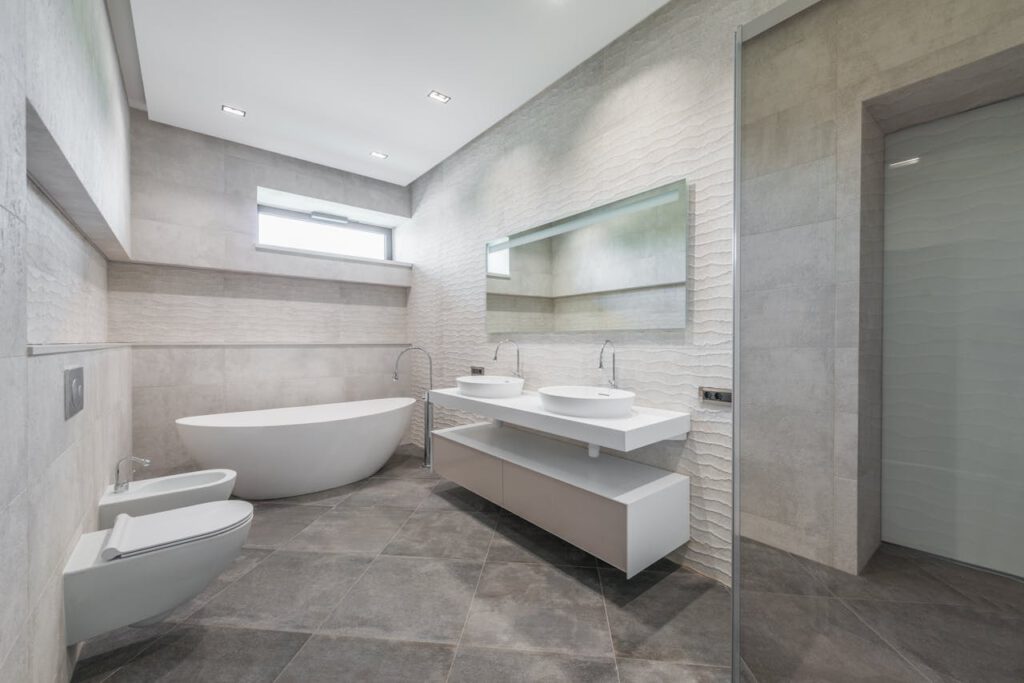You see your bathroom door every day after waking up, bleary-eyed or not. It’s the entrance to your Zen-like oasis. But if the door is flaking off and looking rugged, it’s time to liven it up with some paint.
However, thinking that and doing it are two very different things. Why? Because paint has the power to affect your mood. For example, red can jolt you awake, while white conveys calm. So choosing the wrong color for your relaxing cave can ruin its vibe and your day.
Wondering how not to do that? Let’s go through some no-fail bathroom paint refreshing tips and tricks below.
4 Factors to Keep in Mind Before Choosing a Bathroom Paint Color
Painting is not a breeze. It’s laborious, time-consuming, and costly, so you only want to do it once, not repeat and revise it again and again. So instead of jumping into the choosing game without any care, take a look at the following factors before making your choice:
1. Size
In this case, size does matter. Smaller bathrooms often have a closed-off vibe, so they’ll feel roomier if you paint them in a lighter shade. But if you paint them in darker or bold shades, they’ll either look frumpy or tacky, which isn’t what you want.
Larger or master bathrooms that are too roomy can do with a little darker paint on the ceiling than on the walls, making them a bit cozier. Similarly, you could install a darker backsplash on the bathroom window wall, creating a contrast between the falling sunlight and darker tiles.
2. Flooring
A paint job is just that: a paint job. That means you’re keeping your old flooring (unless you aren’t). So, instead of choosing a color you like for the bathroom walls, select a color that matches your existing flooring.
For instance, if you have blue tiles in the bathroom, bright red wall paint would be the worst option you could go for. Similarly, if you have neutral tile, painting the walls black will just make the bathroom look depressing.
3. Lighting
Lighting can make something simple look gorgeous and cause something gorgeous to look hideous. It’s all a matter of light placement. For instance, if your bathroom has a window, your bathroom paint will get a slight golden tinge when sunlight hits it, making it look warmer than it is.
So, if you’re going for cool-toned paint, hold it up under sunlight to determine if it looks okay. If it looks muddy or grey, switch to a warmer tone.
4. Color Scheme
If your vanity and cabinets are grey, your floor is blue, and your ceiling is green, you’ve got a serious eyesore on your hands. Every visit to the bathroom will be a breathtaking experience. But that’s not what you want in a bathroom.
A bathroom is a place to relax, not choke yourself with horror. So, keep your overall color scheme in mind as you go through a bathroom paint color catalog. Also, try not to clash vibrant colors against each other or make your bathroom look too flat by choosing a similar color for everything.
5 Tips for Choosing Your Ideal Bathroom Paint Color
Whether you’re creating a steal-the-show powder room or a regular old Zen cave, the following tips will help you select the best bathroom colors for a space you’ll love and spend a lot of time in!
1. Take a Look at the Color Wheel
If you have green tile flooring in your bathroom and can’t figure out what’ll go with it, take a look at the color wheel for help. It’ll show you several matching color options, such as blue, gray, bright yellow, pink, brown, and white.
But if you don’t want to use a color wheel or don’t have access to one, Google’s your best friend. Just search for a color that matches your flooring. You can put these colors against your flooring to get an idea of what they’ll look like when painted.
2. Use the Rule of Three
Like the triangle in kitchens, we have the rule of three in bathrooms. The rule says that you should use three colors (according to a contain percentage) to create a bathroom color scheme:
- One neutral color, such as grey or white – 70%
- One rich color, such as green or blue – 20%
- One accent, such as dark green or bright yellow – 10%
- Once you’ve chosen a color, you should use it at least three times in the bathroom. For example, if you’ve chosen white as your neutral color and blue as your rich color, you could put thin stripes of blue on your towels and vanity.
3. Go Neutral for Serenity
If you aim to create an oasis of calm in your bathroom, leave the bright and bold colors behind. Instead, mix two neutrals, like steel gray and marble white, to create a simple but relaxing space. Use a distribution of 70:30. That’ll give the best combination.
However, if the bathroom looks too plain, you can add visual interest by choosing an intricate vanity, using copper or bronze fixtures, or adding textured tile on one wall.
4. Create Contrast with Darker Colors or Two Bright Colors
If you’re a fan of gunmetal grey, deep mahogany, vibrant maroon, or smoky charcoal, you can use them in your bathroom. But to stop your bathroom from looking smaller, accent the paint with a light color or shiny pattern. That way, your bathroom will look more mysterious and sedate than gloomy.
Similarly, if you like bright colors and want to create an energetic atmosphere in your bathroom, choose two bright colors and use them everywhere in your bathroom. Use the 70/20/10 rule.
For example, you could take green as your primary color, yellow as a rich color, and white as an accent around the tub and sink rims.
5. Pair Bright Colors with Neutrals
If you’re not a fan of contrasting bright colors against each other, try pairing a bright and a neutral color. The bright color will provide visual interest, while the neutral will balance any riotousness.
For example, you could contrast crisp white with metallic gray or olive green with speckled brown.
The Takeaway
Choosing a color for your bathroom can feel dreadful because a single color choice mistake can lead to disaster. However, the above tips and tricks can help you create a bathroom space full of life and your preferred atmosphere!
Still confused about color theory and choosing bathroom colors? Take a look at [company’s name]. They’re one of the best bathroom remodeling contractors in New York City.

